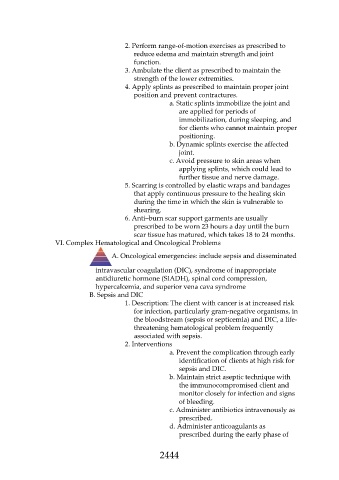Page 2444 - Saunders Comprehensive Review For NCLEX-RN
P. 2444
2. Perform range-of-motion exercises as prescribed to
reduce edema and maintain strength and joint
function.
3. Ambulate the client as prescribed to maintain the
strength of the lower extremities.
4. Apply splints as prescribed to maintain proper joint
position and prevent contractures.
a. Static splints immobilize the joint and
are applied for periods of
immobilization, during sleeping, and
for clients who cannot maintain proper
positioning.
b. Dynamic splints exercise the affected
joint.
c. Avoid pressure to skin areas when
applying splints, which could lead to
further tissue and nerve damage.
5. Scarring is controlled by elastic wraps and bandages
that apply continuous pressure to the healing skin
during the time in which the skin is vulnerable to
shearing.
6. Anti–burn scar support garments are usually
prescribed to be worn 23 hours a day until the burn
scar tissue has matured, which takes 18 to 24 months.
VI. Complex Hematological and Oncological Problems
A. Oncological emergencies: include sepsis and disseminated
intravascular coagulation (DIC), syndrome of inappropriate
antidiuretic hormone (SIADH), spinal cord compression,
hypercalcemia, and superior vena cava syndrome
B. Sepsis and DIC
1. Description: The client with cancer is at increased risk
for infection, particularly gram-negative organisms, in
the bloodstream (sepsis or septicemia) and DIC, a life-
threatening hematological problem frequently
associated with sepsis.
2. Interventions
a. Prevent the complication through early
identification of clients at high risk for
sepsis and DIC.
b. Maintain strict aseptic technique with
the immunocompromised client and
monitor closely for infection and signs
of bleeding.
c. Administer antibiotics intravenously as
prescribed.
d. Administer anticoagulants as
prescribed during the early phase of
2444

